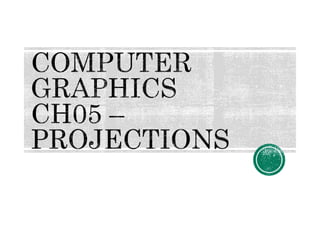
Projection Types and Formulas for Transforming 3D to 2D Coordinates
- 2. Projections: Transform points in coordinate system of dimension N into a coordinate system of dimension less than N. In other word, take a point from m dimensions to n dimensions where N<M. In this chapter we will deal with projection from 3d to 2d There are two types of projections: 1. Parallel. Orthographic. Oblique. 2. Perspective.
- 3. Projection of a 3D object is defined by straight projection rays (projectors) coming from the center of projection passing through each point of the object and intersecting the projection plane. Projections requires: 1. Projections plane. 2. Projections Reference Point (PRP) or Center of Projection (CRP). The projected view of an object is determined by calculating the intersection of projection lines with the view plane. Projectors: Lines from coordinate in original space to coordinate in projected space.
- 4. In parallel projections, coordinate positions are transformed to the view plane (projection plane) along parallel lines (projectors). In perspective, object position are transformed to the view plane along lines that converge to COP. In orthographic the direction of projection = normal to the projection plane. In oblique the direction of projection != normal to the projection plane. Direction/Center of projection: The main key factors in projection are DOP and COP.
- 5. If the DOP is the same for all point, then we have parallel projection, else we have perspective projection. If the distance of COP is finite, then we have perspective projection, else we have parallel projection. In general, projection is determined by where you place the projection plane relative to principle axes of object (relative angle and position), and what angle the projection make within the projection plane.
- 6. Perspective: Size varies inversely with distance (Looks realistic). Distance and angle are not preserved. Parallel lines do not remain parallel. Parallel: Less realistic. Angles are not preserved. Parallel lines remain parallel. Good for exact measurement.
- 8. In Orthographic there is no COP at infinity and A=A’ and B=B’, but in Oblique COP at infinity
- 9. Perspective projection of a point P with coordinates (X,Y,Z) to position (X’,Y’,Z’) on the view plane.
- 10. X’= X - XU. Y’= Y - YU. Z’= Z – (Z-ZPRP). Parameter U takes values from 0 to 1. When U= 0. X’= X. Orthographic parallel projection Y’= Y. When U= 1. X’= 0 Y’= 0 (0,0,ZPRP) so the point is at projection Z’= ZPRP. Reference point PRP
- 11. On the view plane Z’= ZVP. U= (ZVP – Z) / (ZPRP – Z). XP= X ((ZPRP – ZVP) / (Z – ZPRP)) = X (dP / (Z-ZPRP)) YP= Y ((ZPRP – ZVP) / (Z – ZPRP)) = Y (dP / (Z-ZPRP)) Where dP = ZPRP – ZVP is the distance of the view plane VP from the projection reference plane PRP. Using 3d homogeneous-coordinate representation, we can write the perspective projection transformation as
- 12. Xh = X. Yh = Y. Zh = Z (ZVP / dP) – ZVP (ZPRP / dP). h= (Z / dP) – (ZPRP / dP) XP = Xh / h. YP = Yh / h.
- 13. EX: If you have a point (2,4,6) and you want to project using perspective projection, suppose that ZPRP=20 and ZVP=10. dP= ZPRP – ZVP= 20-10 = 10. XP= X (dP / (Z-ZPRP))= 2 (10/-14). YP= Y (dP / (Z-ZPRP))= 4 (10/-14). Using 3d homogenous coordinate: Xh = 2, Yh = 4. h= (6 / 10) – (20 / 10)= -14/10. XP = 2 / (-14/10)= 20/-14. YP = 4 / (-14/10)= 40/-14.
- 14. Oblique projection of coordinate position (X,Y,Z) to position (XP,YP) on the view plan.
- 15. X’= L * Cos θ. Y’= L * Sin θ. XP= X + X’= X + L * Cos θ. YP= Y + Y’= Y + L * Sin θ. Length L depends on the angle α and the Z coordinate of the point to be projected Tan α= Z/L. L= Z/tan α= ZL1, where L1 is the inverse of tan α which is also the value of L when Z = 1. We can then write the oblique projection equations as: XP= X + Z(L1 Cos θ). YP= Y + Z(L1 Sin θ).
- 16. X’= L * Cos θ. An orthographic projection obtained when L= 0. Common choices for θ in 30 and 45, which display a combination view of the top, bottom and sides.
- 17. EX: If you have a point (2,5,7) and you want to project using oblique projection, suppose that θ=45 and α=45. L1= 1/tan α= 1. XP= X + Z(L1 Cos θ)= 2 + 7(1 Cos 45)= 2+(7/ 2). YP= Y + Z(L1 Sin θ)= 5 + 7(1 Sin 45)= 5+(7/ 2).
- 18. EX: If you have a point (3,4,6) and you have θ=45,α=45, ZPRP=5 and ZVP=2. Find the new coordinate using : (A)Perspective (B)Orthographic (C)Oblique. (A) dP= ZPRP – ZVP= 5-2 = 3. XP= X (dP / (Z-ZPRP))= 3 (3/1)= 9. YP= Y (dP / (Z-ZPRP))= 4 (3/1)= 12. (B) XP= 3, YP= 4 Just drop Z. (C) L1= 1/tan α= 1. XP= X + Z(L1 Cos θ)= 3 + 6(1 Cos 45)= 3+(6/ 2). YP= Y + Z(L1 Sin θ)= 4 + 6(1 Sin 45)= 4+(6/ 2).